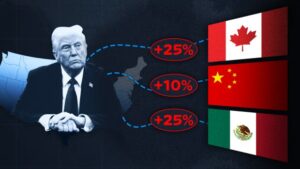Event Recap: Policy Shock and Market Contagion
On February 27, 2025, U.S. President Trump announced a 10% tariff hike on Chinese goods and plans to impose 25% tariffs on Mexican and Canadian imports, triggering global market turmoil. The crypto sector was hit hard, with Bitcoin plunging below $80,000 and altcoins crashing. The market fear index spiked to 5, eroding investor confidence. Since Trump’s 2024 election win, his protectionist policies have repeatedly destabilized markets, while regulatory crackdowns in Turkey and India (February 5) amplified crypto’s fragility.

How Tariffs Impact Crypto
- Macroeconomic Pressure on Risk Assets
Trump’s tariffs fuel global trade friction fears, strengthening the U.S. dollar and pressuring risk assets. Crypto’s correlation with traditional markets intensified capital flight from Bitcoin and Ethereum. Per AIcoin, U.S. Bitcoin ETFs saw $2.708 billion in net outflows over four days, reflecting institutional risk aversion. - Policy Uncertainty Fuels Panic
Trump’s erratic tariff moves—like adding another 10% duty on March 4 after February 1’s hike—make stable expectations impossible. This uncertainty magnifies crypto volatility, driving investors to cash or gold.
Historical Parallels: Trade Wars and Crypto
During the 2018 U.S.-China trade war, Bitcoin fell over 50% from 18,000to3,000. Current parallels include:Dollar Strength, Fed rate hikes and tariffs boost the dollar, dampening crypto appeal.Tech-Crypto Link:,Tariffs hurt tech giants (e.g., Ford, GM’s China operations), dragging down crypto as a high-risk asset.Regulatory Fragmentation, Divergent policies (EU sanctions, Turkey’s fiat curbs) exacerbate volatility.
New variables today—institutional dominance (BTC ETFs hold 1.2M BTC) and Layer-2 cost reductions—may cushion the downturn. Bitcoin’s price nearing miners’ breakeven levels could also provide support.
Industry Recommendations: Strategies and Planning
Short-Term Adjustments
- Reduce Leverage: Use ≤5x leverage; prioritize spot trading.
- Monitor Policy Signals: Track SEC actions and state-level bills (e.g., South Dakota’s HB1202).
- Capitalize on Volatility: Consider staggered buys if Bitcoin tests $78,000 support.
Long-Term Focus
- Compliance Trends: Traditional institutions (e.g., JPMorgan) expanding crypto custody may benefit regulated exchanges and miners.
- Tech Adoption: Watch Ethereum Layer-2 adoption and Bitcoin Lightning Network growth.
- Geopolitical Hedging: Prepare for secondary shocks from Middle East tensions or tech stock crashes.
Retail investors can track real-time prices via JuCoin.
Market Insights: Testing Crypto’s Resilience
This tariff shock reaffirms crypto’s dual identity: a tech innovation frontier and a macro risk amplifier. While Bitcoin’s “digital gold” narrative remains tied to traditional markets, its core value propositions—decentralization and censorship-resistant payments—are irreplaceable.
Policy black swans won’t destroy blockchain’s foundations but will weed out over-leveraged speculators. For investors, staying rational and focusing on tech evolution and compliance may be the key to navigating cycles.




